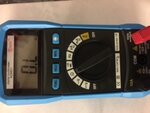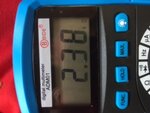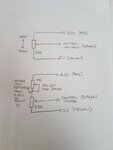Follow along with the video below to see how to install our site as a web app on your home screen.
Note: This feature may not be available in some browsers.
Good!
What you need to do is work out which wire is which. At the speed control, measure the voltage from each wire to each other wire. What you are trying to find out is which two have a steady voltage on them and which has the voltage that varies with the pedal position. Of the two steady ones (there might be a slight fluctuation as the pedal is pushed but it should be fairly small) you need to finds out which is the more negative voltage. Then, with the negative meter probe (usually black) on that wire and positive probe (usually red) on the wire that changes with pedal position, read the voltage at 'stop' and at maximum speed. I advise you not do this while the car is in motion unless you can run fast! Let me know the two voltages.
It would also be a great help if you could unplug the wires from the control and use the meter to measure resistance (Ohms) across the points ON THE CONTROL the two fixed voltage wires went to. You can probably do this from the socket the wires were plugged into. I would expect the resistance to be somewhere between about 1000 Ohms (1K) and 100,000 Ohms (100K) to give you some confidence you have the right connections. Don't worry about the contact the varying voltage wire went to as it will change value as the pedal is moved anyway. The resistance across the fixed voltage points will effectively be the value of the control and from that and the voltage you measured we can work out a suitable addition to limit the speed.
Good Luck.
Brian.
As you are now inside the component level identification , it will be better if you attach a closeup photo of the accelerator pedal resistor with wires .
Hmmm....
Something doesn't look right there. I wonder if there are other components inside the box with the variable resistor. I can understand two of the wires having low resistance between them if it was a standard potentiometer (a variable resistor where both ends of a carbon track and a wiper along it's length are present) because the wiper would be at one end of the track with the control in it's 'relaxed' state but there should be a reading to the other wire regardless.
Also, if the 2.4 Ohms is between the yellow and red wires which we previously measured 4.35V across, it would imply about 2 Amps would flow through it. That would require fairly thick wires and the resistor would run very hot. Does you testmeter have 'autoranging' or does it have a manual resistance range selector? I have a feeling the number may be wrong.
Brian.

Hmmm....
Something doesn't look right there. I wonder if there are other components inside the box with the variable resistor. I can understand two of the wires having low resistance between them if it was a standard potentiometer (a variable resistor where both ends of a carbon track and a wiper along it's length are present) because the wiper would be at one end of the track with the control in it's 'relaxed' state but there should be a reading to the other wire regardless.
Also, if the 2.4 Ohms is between the yellow and red wires which we previously measured 4.35V across, it would imply about 2 Amps would flow through it. That would require fairly thick wires and the resistor would run very hot. Does you testmeter have 'autoranging' or does it have a manual resistance range selector? I have a feeling the number may be wrong.
Brian.


The new control is easy to wire in, just break the existing red wire and connect it across the cut. Try to position it where it can't easily be reached or your son will soon work out how to beef things up again! The potentiometer you need can be very small, something like these:
Brian.
That's quite funny, it exactly describes what a potentiometer does! I can almost hear the howls of laughter from other users on here: "that's not the accelerator, it's the pedal to make it go faster" :grin:The resistance measurement is of no interest. The thing you call a "variable resistor" is not a resistor at all. It is an electronic device that takes two power leads in and outputs a voltage dependent on the position of sliding pieces.
That potentiometer should be fine, use 10K value. If you use a smaller value you get less restriction of top speed, use the next value up (100K) and will restrict it far too much, in fact it may not move at all.
That's quite funny, it exactly describes what a potentiometer does! I can almost hear the howls of laughter from other users on here: "that's not the accelerator, it's the pedal to make it go faster" :grin:
The resistance DOES matter, in fact without knowing it the additional resistance to set the speed limit can't be deduced.
It is true that the lower speed will also be reduced but I assume if the pedal isn't pressed at all the car doesn't move so I doubt that would be a problem. If it is, there is another simple fix but don't worry about that yet.
If you buy the potentiometer in the link, you only need two connections, across the cut in the original red wire. Use one of the end tags as one connection and link the middle and other end tag as the other connection.
Brian.

I think there are three wires, the middle is white but doesn't show against the background in the picture. The colours have no particular meaning, it looks like a left over spare part for a piece of equipment where the original manufacturer decided on which wires to use. The position of the wires on the control is what matters. Hopefully this will make it clear:
View attachment 149161
There is no need to remove the wires from the new control, in this application the lengths don't matter so if you chop the plug off and leave the red/white/black wires as long as you need them, you can easily join them across the break in the original red wire.
It doesn't matter which end of the new control you link to the middle, all it changes is the direction to set maximum speed, clockwise or anti-clockwise but the adjustment will work exactly the same.
Brian.